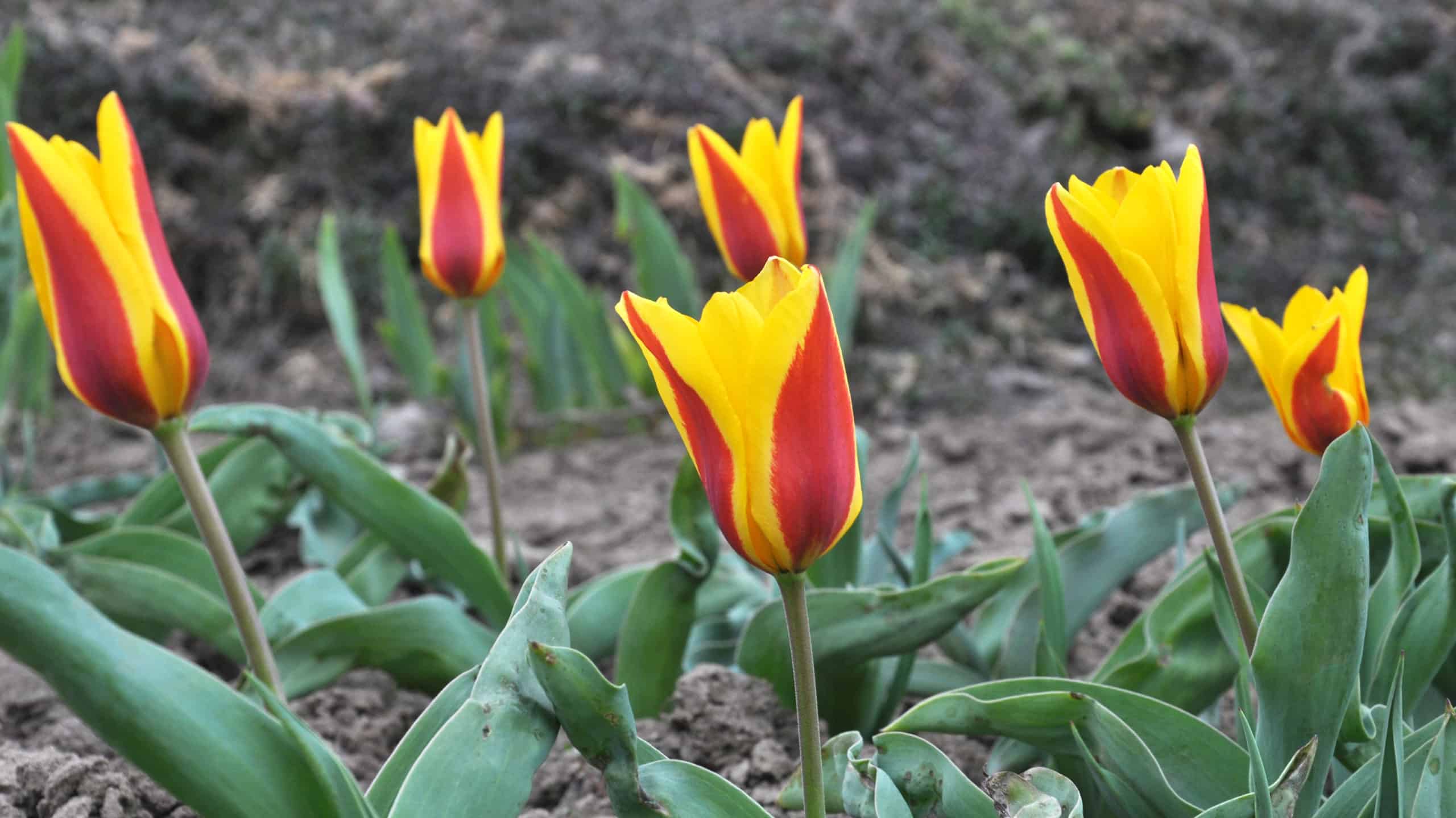Positioned in the Deep South of the United States, Alabama consistently ranks among the top ten hottest weather in the United States each year. With the Gulf of Mexico as its southern border, it’s no surprise that tropical plants and flowers thrive in the state.
But does that mean that spring flowers such as tulips can’t grow there? Not at all. But it does mean that Alabama gardeners will have to approach tulip-growing a bit differently than their northern counterparts.
Alabama’s plant hardiness zones range from Zone 7a around Huntsville to Zone 9a in Mobile. A difference of only two zones within the state may not sound like much to us, but we’re not tulips. To those iconic spring flowers, that range makes a huge difference.
Get to Know the Tulip
The Tulipa genus includes around 150 species with over 3,000 cultivars. They are divided into 15 different classifications based on shape, height, and when they bloom.
| Tulip Facts | |
|---|---|
| Botanical name | Tulipa spp. |
| Common Name | Tulip |
| Plant Type | Perennial, bulb |
| Sunlight | Full |
| Soil | Rich, well-drained |
| Bloom Season | Spring |
| Toxicity | Toxic to both humans and pets |
Types
With so wide a variety of tulips available, how do gardeners know which ones to choose? Climate has a significant bearing on the success or failure of tulips, so let’s narrow it down.
Here are four tulips that Alabamians can consider for their gardens and flowerbeds.
1. Alibi Tulip
The Alibi tulip is a member of the group known as Triumph Tulips. Triumphs fare better in warmer growing zones than some other tulip varieties.
The blooms are a majestic purple, sitting atop stout stems that are able to withstand the winds and rainstorms that roll through Alabama in the spring.
The Alibi isn’t the only Triumph Tulip for Alabama gardeners to consider, though. Other Triumphs that can adapt to Alabama’s climate conditions include the Purple Flag, Pim Fortuyn, Jimmy, and Ronaldo varieties.
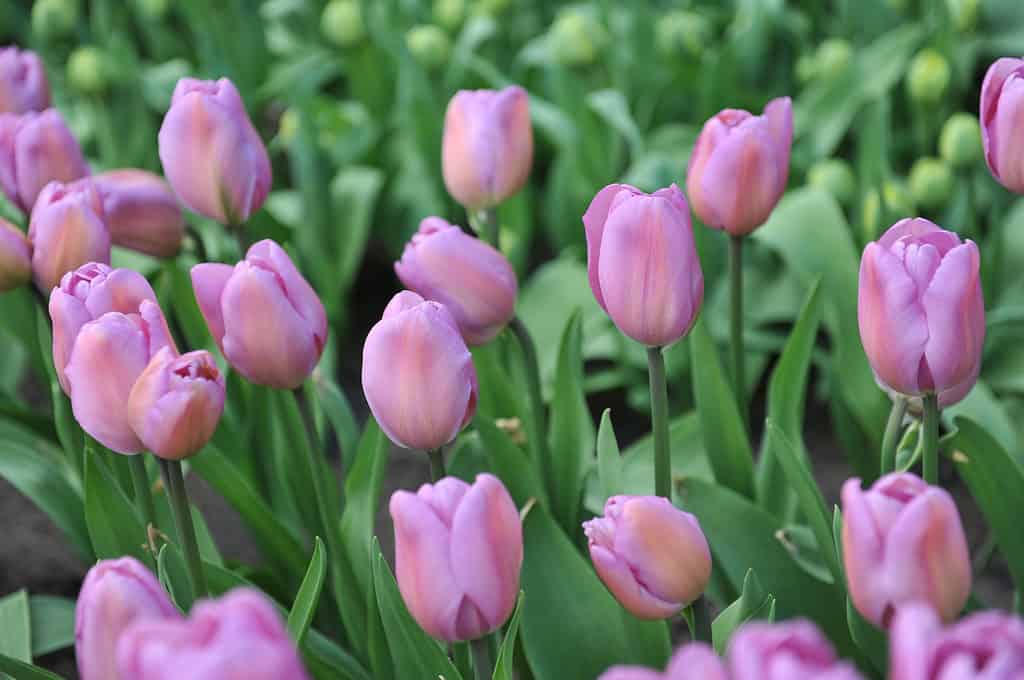
Purple Alibi tulips in a garden.
©Sergey V Kalyakin/Shutterstock.com
2. Lady Tulip
Also known as Clusius’s Tulip, the Lady Tulip is native to Afghanistan, Iran, Iraq, and Pakistan.
It is recommended up to Zone 7, so it’s a good choice for northern Alabama gardeners, but southerners may want to choose a different variety.
Lady Tulips feature grayish-green foliage and more tender stems than Triumph Tulips. In addition, their creamy white or light yellow blooms are edged in red or dark pink, making them truly stunning spring flowers.
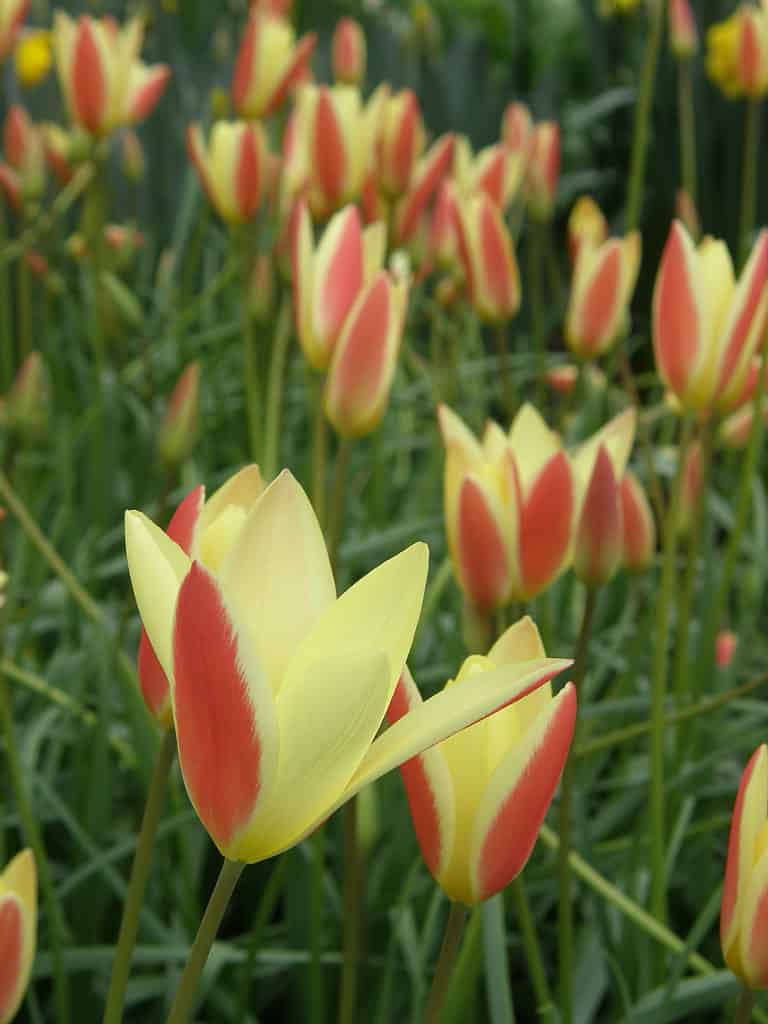
Yellow and red lady tulips in a garden.
©Sergey V Kalyakin/Shutterstock.com
3. Hocus Pocus Tulip
Hocus Pocus tulips are part of the Single Late Tulips grouping. They feature large, lily-like blooms in a spectacular bright yellow color with red flame-like accents.
Like most Single Lates, these tulips can withstand high winds and heavy rains.
One of the most adaptable tulips to warm weather, some experts claim the Hocus Pocus tulip is rated for growing in zones as high as Zone 9. So this tulip should definitely be on the list for gardeners in southern Alabama.
Most Single Late tulips can withstand warmer conditions than some other varieties, so if you can’t locate the specific Hocus Pocus tulip, another Single Late hybrid is likely a good choice.
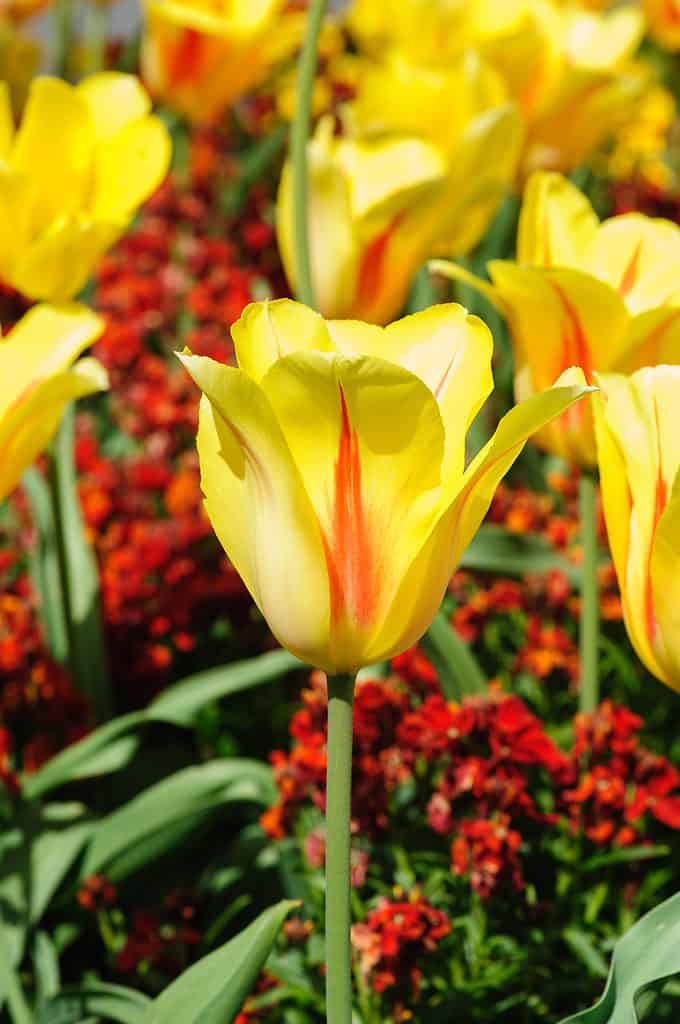
Yellow and red-accented Hocus Pocus tulips in a garden.
©CTatiana/Shutterstock.com
4. Johann Strauss Tulip
The Johann Strauss tulip is part of the Kaufmanniana tulip group. Kaufmanniana tulips are often referred to as water lily tulips.
The Johann Strauss tulip sports the signature water lily-like bloom on a relatively short stem.
Named after the famous Austrian composer Johann Baptist Strauss (1825 – 1899), this stunning tulip features yellow-white flowers with beautiful red accents outside its petals.
Additional Kaufmanniana tulips that Alabamian gardeners could consider are the Hearts Delight, Stresa, and Chopin varieties.

Close-up of the white, yellow, and red petals of the Johann Strauss tulip.
©Inachis Projekt/Shutterstock.com
Planting Tips
Once you choose the varieties for your garden, what comes next? Here are some important things to remember for growing tulips in the warm Alabama climate.
Bulb Selection
Selecting the right varieties of tulips means little if the bulbs are in poor condition. The bulb is the storehouse for all the nutrients that the flower will tap into as it grows. Since tulips are less adapted to the warmer growing zones in Alabama, they will need every last nutrient they can get to flourish.
You don’t want to plant soft, squishy, or moldy bulbs. Instead, choose large bulbs that are free of streaks, spots, or cracks.
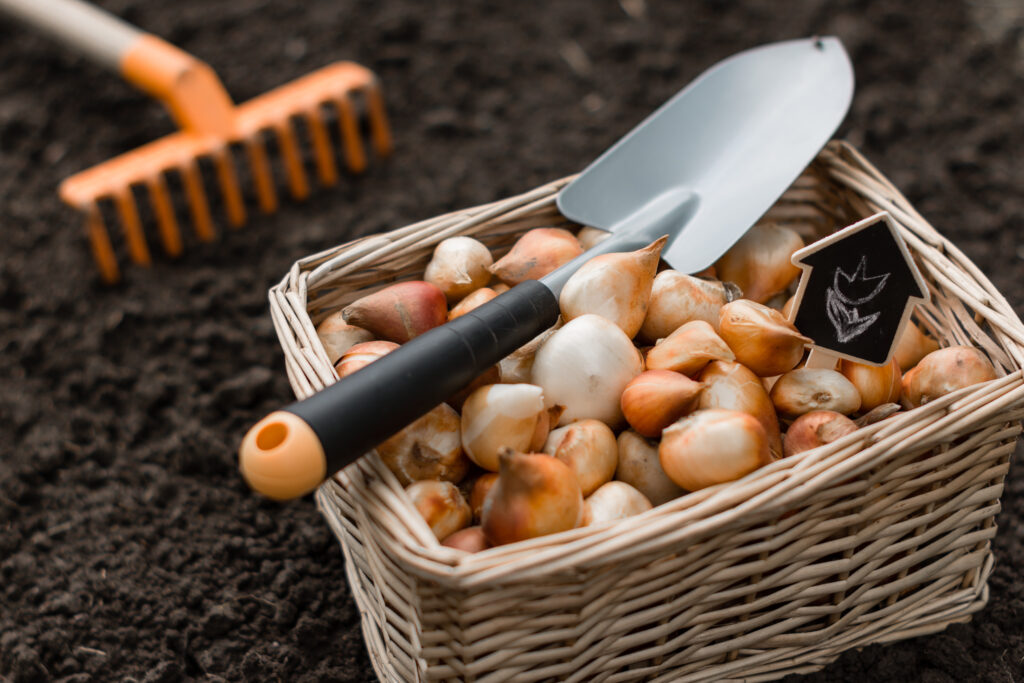
Tulip bulbs, garden spade, and rake.
©Jurga Jot/Shutterstock.com
When to Plant
Deciding when to plant tulip bulbs depends on the plant hardiness zone where you live.
Tulip bulbs require cold conditions to emerge from dormancy. Without this cold stratification period, the flowers will either be malformed or simply won’t grow at all.
The ideal time to plant bulbs is when the soil temperature is below 55°F.
In northern Alabama’s Zone 7, that generally means that planting in November is a good guideline.
In central Alabama’s Zone 8, plan on planting in December.
(Always check the actual soil temperature to be sure. These are just ballpark estimates.)
But what about the southern part of the state, those toasty areas in Zone 9? This is where the timing gets a little more complicated.
Chilling Tulip Bulbs
If tulips need cooler soil to begin growing, what do you do if the soil in your area doesn’t reach those cooler temps or doesn’t stay cool long enough?
You have to “trick” the tulip bulbs. It’s not a magic trick, though (even if the Hocus Pocus tulip might suggest otherwise).
Instead, it’s done through simple refrigeration. Suppose the soil in a region won’t dip to the needed temperatures for the necessary duration. In that case, growers can place their tulip bulbs in a refrigerator to coax the bulbs to emerge out of dormancy.
The length of chill time depends on the hardiness zone, but for the zones of southern Alabama, a period of 10 to 14 weeks is necessary. You can chill bulbs longer than that if you wish, but don’t go any shorter, or you risk stunting the biochemical reaction that is taking place inside the bulbs.
So how do you know if you need to chill your bulbs in a refrigerator before planting? If you live in Zone 9, the answer is simple: you do! Without pre-chilling, tulip bulbs have little, if any, chance to grow in this zone.
Chilling is actually recommended for residents of Zone 8, as well. We’re looking at you, Tuscaloosa and Montgomery!
There are years where it’s probably less necessary than others. However, growers in central Alabama will see better spring tulip production by chilling bulbs before planting.
While chilling the bulbs in the fridge, air circulation is important. Keep your bulbs in ventilated bags or boxes. Don’t store them in an airtight container. That will cause the bulbs to rot due to excessive moisture retention.
Also, don’t use the same refrigerator for bulbs and your favorite fruits. Fruits, especially apples, emit ethylene gas during the ripening process. This gas is harmful to tulip bulbs.
After the bulbs have chilled for the requisite amount of time, they are ready to be planted, usually in late December or early January.
Where to Plant
Tulips love sunshine and don’t like being waterlogged. So choose a growing site that receives 4-6 hours of sunlight a day. Growers in the northern part of the state can lean toward more sun, but gardeners in the south will need to give their tulips a bit more shade.
Providing your tulips with fertilizer can give them an extra boost. Use a slow-release fertilizer. One with a nutrient ratio of 9-9-6 is ideal.
If you’d rather use an organic mix, you can use equal parts greensand, bone meal, and blood meal.
Plant the bulbs with the pointed side up about 8-10 inches deep. Space the bulbs 3-4 inches apart.
As you consider planting options, here’s one more little piece of advice to make your life easier…ignore the word “perennial” anytime you see it attached to tulips.
Yes, tulips are technically perennial flowers, but they will not grow as such in the warm zones of the southern US. Save yourself the headache and just pretend you’ve never heard of a perennial tulip. Care for them as you would an annual flower. After the growing season, dig up the bulbs and plant new ones in the fall.
Toxicity
Tulip bulbs contain alkaloid and glycoside compounds that are mildly toxic to humans and moderately toxic to pets.
Gardening gloves are highly recommended when handling bulbs or blooms to prevent “tulip fingers,” a skin rash well-known and much-despised by those who tend tulips.
Common Pests
As with most flowers, there are some pests that can damage your tulips.
Aphids and Spider Mites
These pests are the bane of tulip growers throughout the United States, and Alabama is no different.
If aphids or spider mites are munching on your tulips, spraying insecticidal soap over the flowers can help eliminate the infestation. If that fails to fully eliminate the pests, a chemical insecticide could be used to eradicate them.
Wildlife Problems
Alabama is filled with wildlife, and tulips are like candy to a lot of these critters.
Squirrels, for example, love to dig up freshly planted tulip bulbs in the fall as they stock up for winter. But, as recommended above, planting at a deeper depth can deter these critters.
Woodland voles will also use your tulip bulbs as an easy meal. If these burrowing critters are giving you problems, there are a few options.
You can construct chicken wire cages to protect your bulbs. The holes will allow bulbs to take root but keep voles and other burrowers away.
You could also add a layer of gravel or grit above and below your bulbs. Digging through sharp materials is unpleasant for these animals, and they’ll generally avoid it.
Rabbits love to munch on new tulip shoots as they emerge from the ground.
And with one of the largest whitetail deer populations per square mile in the nation, your tulips are sure to be tasty targets for those four-legged herbivores.
Consider using a commmercial repellent to keep the rabbits and deer at bay. It’s not an impenetrable barrier for these critters but it can help.

Large whitetail deer buck in a meadow.
©EEI_Tony/Shutterstock.com
Final Thoughts
Cultivating tulips in warm-weather states like Alabama is admittedly more difficult than more northern states, but it can be done. Yes, it does require planning, effort, and timing, but the payoff will be awesome when your garden is the envy of the whole neighborhood in the spring!
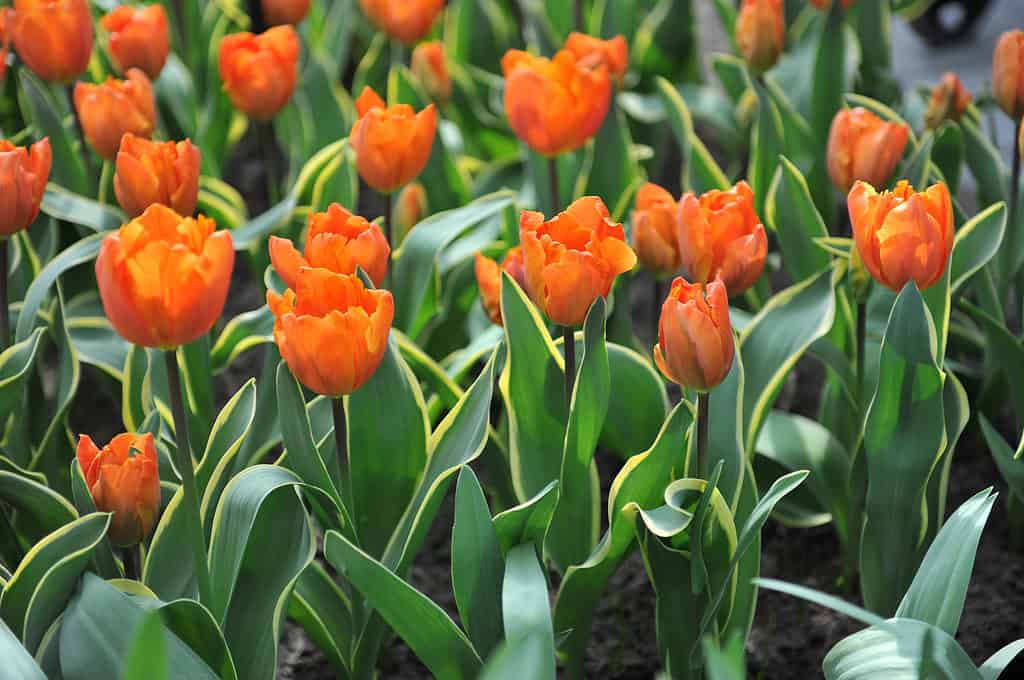
Variegated orange Triumph tulips in a garden.
©Sergey V Kalyakin/Shutterstock.com
Thank you for reading! Have some feedback for us? Contact the AZ Animals editorial team.

